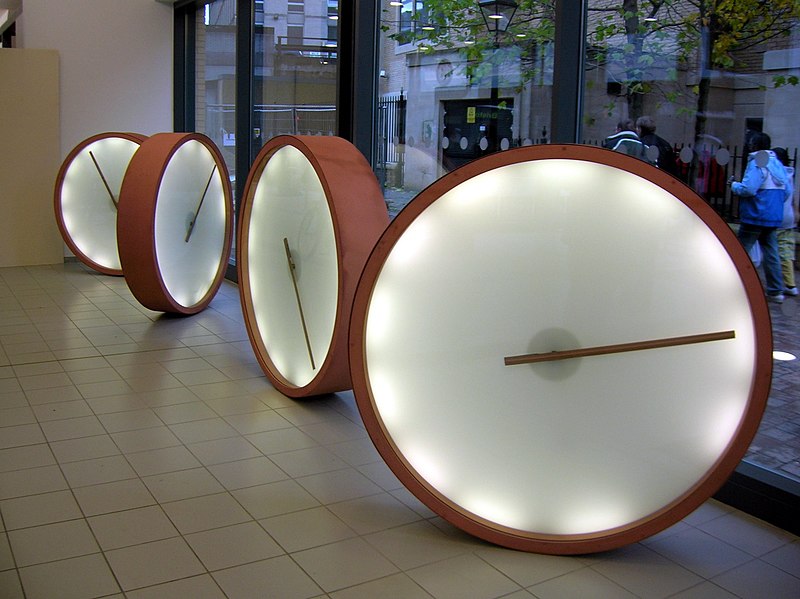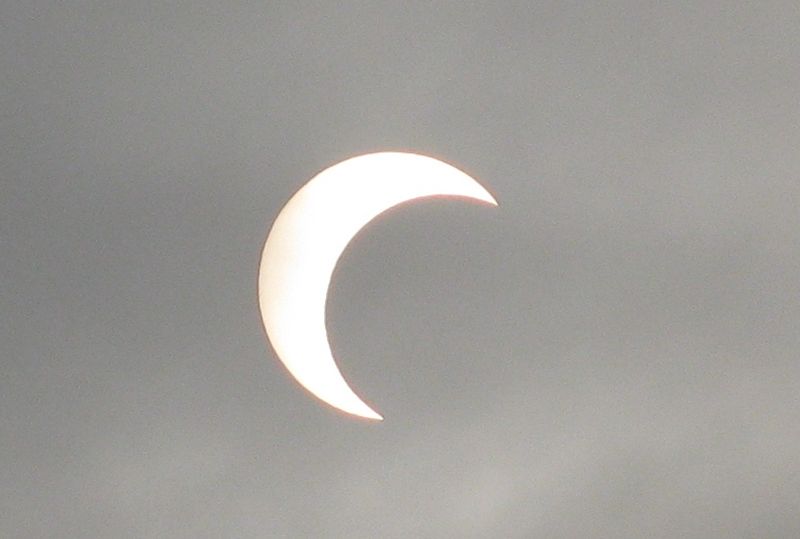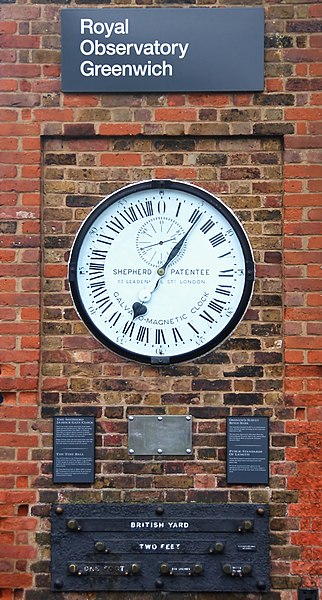.

Sun, street light and Parallax effect: photo by Mila Zinkova, 2008
Timeball on the ballast office is down. Dunsink time. Fascinating little book that is of sir Robert Ball's. Parallax. I never exactly understood. There's a priest. Could ask him. Par it's Greek: parallel, parallax.
He crossed at Nassau street corner and stood before the window of Yeates and Son, pricing the field glasses. Or will I drop into old Harris's and have a chat with young Sinclair? Well-mannered fellow. Probably at his lunch. Must get those old glasses of mine set right. Goerz lenses, six guineas. Germans making their way everywhere. Sell on easy terms to capture trade. Undercutting. Might chance on a pair in the railway lost property office. Astonishing the things people leave behind them in trains and cloak rooms. What do they be thinking about? Women too. Incredible. Last year travelling to Ennis had to pick up that farmer's daughter's bag and hand it to her at Limerick junction. Unclaimed money too. There's a little watch up there on the roof of the bank to test those glasses by.

Bristol bus station clocks: photo by Rob Brewer, 2005
His lids came down on the lower rims of his irides. Can't see it. If you imagine it's there you can almost see it. Can't see it.
He faced about and, standing between the awnings, held out his right hand at arm's length towards the sun. Wanted to try that often. Yes: completely. The tip of his little finger blotted out the sun's disk. Must be the focus where the rays cross. If I had black glasses. Interesting. There was a lot of talk about those sunspots when we were in Lombard street west. Terrific explosions they are. There will be a total eclipse this year: autumn some time.
Ah.
His hand fell again to his side.
Never know anything about it. Waste of time. Gasballs spinning about, crossing each other, passing. Same old dingdong always. Gas, then solid, then world, then cold, then dead shell drifting around, frozen rock like that pineapple rock. The moon. Must be a new moon, she said. I believe there is.
Moon Phase: New Moon: image by Daniel Kmiec, 2007
Sir Robert Stawell Ball (1840-1913), Royal Astronomer of Ireland and Andrews Professor of Geometry and Astronomy in the University of Dublin at Dunsink Observatory: Leslie Ward, 1905
He crossed at Nassau street corner and stood before the window of Yeates and Son, pricing the field glasses. Or will I drop into old Harris's and have a chat with young Sinclair? Well-mannered fellow. Probably at his lunch. Must get those old glasses of mine set right. Goerz lenses, six guineas. Germans making their way everywhere. Sell on easy terms to capture trade. Undercutting. Might chance on a pair in the railway lost property office. Astonishing the things people leave behind them in trains and cloak rooms. What do they be thinking about? Women too. Incredible. Last year travelling to Ennis had to pick up that farmer's daughter's bag and hand it to her at Limerick junction. Unclaimed money too. There's a little watch up there on the roof of the bank to test those glasses by.

Bristol bus station clocks: photo by Rob Brewer, 2005
His lids came down on the lower rims of his irides. Can't see it. If you imagine it's there you can almost see it. Can't see it.
Eclipse, Hanoi, Viet Nam, 15 January 2010: photo by Huangvantoanajc, 2010
He faced about and, standing between the awnings, held out his right hand at arm's length towards the sun. Wanted to try that often. Yes: completely. The tip of his little finger blotted out the sun's disk. Must be the focus where the rays cross. If I had black glasses. Interesting. There was a lot of talk about those sunspots when we were in Lombard street west. Terrific explosions they are. There will be a total eclipse this year: autumn some time.
Shepherd Gate Clock, Royal Observatory, Greenwich, UK: photo by Alvesgaspar, 2007
Now that I come to think of it, that ball falls at Greenwich time. It's the clock is worked by an electric wire from Dunsink. Must go out there some first Saturday of the month. If I could get an introduction to professor Joly or learn up something about his family. That would do to: man always feels complimented. Flattery where least expected. Nobleman proud to be descended from some king's mistress. His foremother. Lay it on with a trowel. Cap in hand goes through the land. Not go in and blurt out what you know you're not to: what's parallax? Show this gentleman the door.Ah.
His hand fell again to his side.
Never know anything about it. Waste of time. Gasballs spinning about, crossing each other, passing. Same old dingdong always. Gas, then solid, then world, then cold, then dead shell drifting around, frozen rock like that pineapple rock. The moon. Must be a new moon, she said. I believe there is.
Moon Phase: New Moon: image by Daniel Kmiec, 2007

Ulysses: James Joyce, 1922, Paris, first edition cover, image by Lupo, 2006
James Joyce: from Ulysses, 1922







2 comments:
Brilliant. The way he slips in and out of omniscient pov and stream of consciousness, with an ease no one, to my reading knowledge, has ever surpassed.
Have read this section many times and, aside from Bloom's usual preoccupation with scientific (among many other) things, the parallax view seems almost to be the author's, with Stephen and Bloom being two points and Molly the "fixed" object. Of course, with Joyce it probably was so many, many other things, too.
How he breathed life into LB, made him truly, truly live, for me was the real triumph. I feel I know him better than many people I've met and interacted with.
Yes, Don, isn't it wonderful to come back and see that this work of genius was here all along.
Your analysis of how JJ employs the parallax effect makes good enough sense.
Displacement or difference created by alteration of POV, thus a distancing and defamiliarization of objects, estrangement of the everyday, effected at the level of technique.
This is the world we know we don't know, made into narrative for the first time.
Mila Zinkova says this about her photo:
"I've noticed that the reflection of the sun is seen at the reflection of the street light while the sun itself is much higher than the street light is. I've asked Andy Young to explain my image.
"Here's what he says:
"'The answer is Parallax. The reflection in the water shows the view as seen from a point that is the camera's reflection in the water -- i.e., as far below the surface as the camera is above it.
"'The street light is much closer than the Sun; so parallax mainly affects the position of the light's reflected image.
"'These perspective effects are *always* present in pictures of reflections in water -- but not often as obvious as in your picture, which is a 'textbook example' of the effect.'"
Here one can see the parallax effect produced with solar reflection upon a shimmering face of Argentine agate.
(Of course there's the very spooky use of the effect as cultural/historical metaphor for mindconditioning in Alan J. Pakula's 1974 film version of The Parallax View, from which the six minute clip of The Parallax Test has become a classic and is plastered all over the net.)
Post a Comment